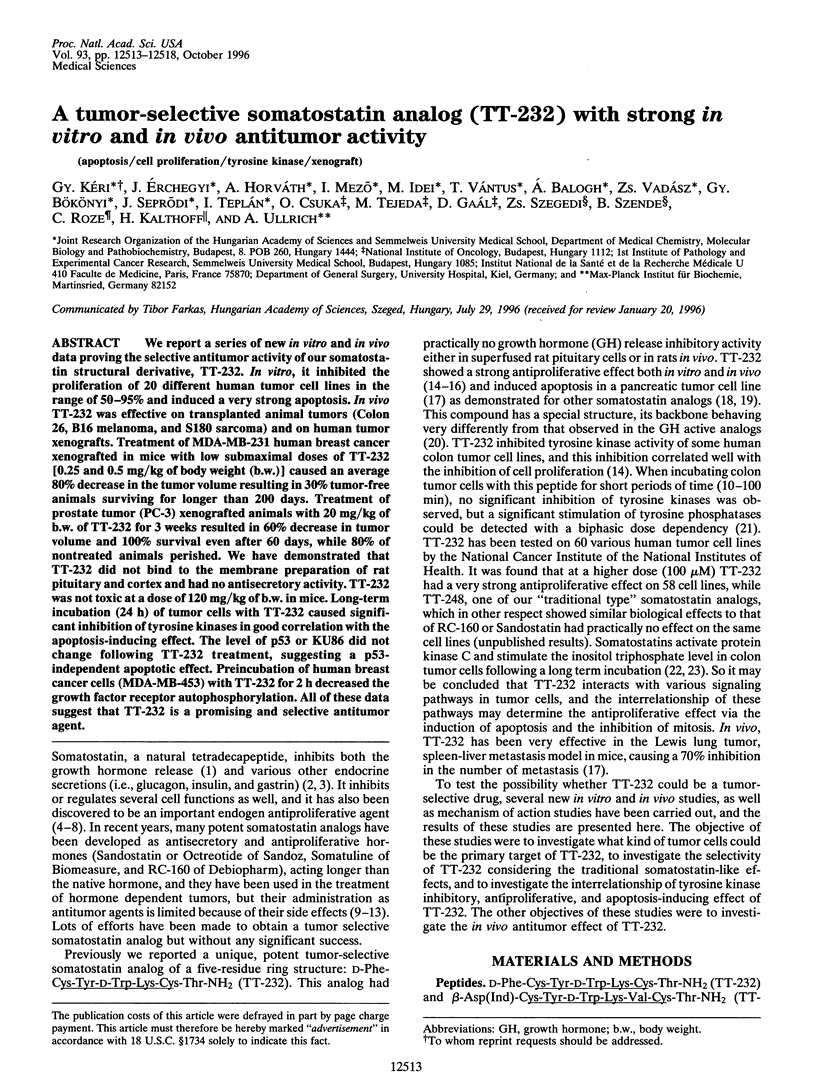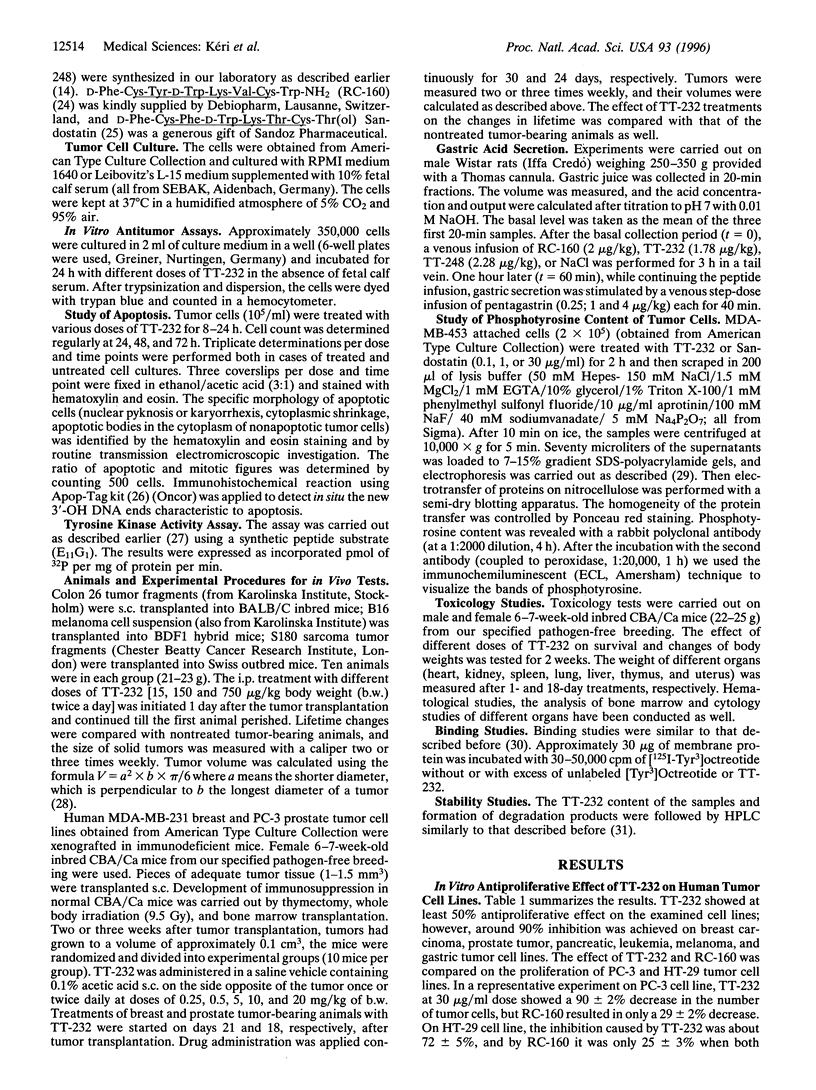Abstract
We report a series of new in vitro and in vivo data proving the selective antitumor activity of our somatostatin structural derivative, TT-232. In vitro, it inhibited the proliferation of 20 different human tumor cell lines in the range of 50-95% and induced a very strong apoptosis. In vivo TT-232 was effective on transplanted animal tumors (Colon 26, B16 melanoma, and S180 sarcoma) and on human tumor xenografts. Treatment of MDA-MB-231 human breast cancer xenografted in mice with low submaximal doses of TT-232 [0.25 and 0.5 mg/kg of body weight (b.w.)] caused an average 80% decrease in the tumor volume resulting in 30% tumor-free animals surviving for longer than 200 days. Treatment of prostate tumor (PC-3) xenografted animals with 20 mg/kg of b.w. of TT-232 for 3 weeks resulted in 60% decrease in tumor volume and 100% survival even after 60 days, while 80% of nontreated animals perished. We have demonstrated that TT-232 did not bind to the membrane preparation of rat pituitary and cortex and had no antisecretory activity. TT-232 was not toxic at a dose of 120 mg/kg of b.w. in mice. Long-term incubation (24 h) of tumor cells with TT-232 caused significant inhibition of tyrosine kinases in good correlation with the apoptosis-inducing effect. The level of p53 or KU86 did not change following TT-232 treatment, suggesting a p53-independent apoptotic effect. Preincubation of human breast cancer cells (MDA-MB-453) with TT-232 for 2 h decreased the growth factor receptor autophosphorylation. All of these data suggest that TT-232 is a promising and selective antitumor agent.
Full text
PDF





Selected References
These references are in PubMed. This may not be the complete list of references from this article.
- Bauer W., Briner U., Doepfner W., Haller R., Huguenin R., Marbach P., Petcher T. J., Pless SMS 201-995: a very potent and selective octapeptide analogue of somatostatin with prolonged action. Life Sci. 1982 Sep 13;31(11):1133–1140. doi: 10.1016/0024-3205(82)90087-x. [DOI] [PubMed] [Google Scholar]
- Bogden A. E., Taylor J. E., Moreau J. P., Coy D. H., LePage D. J. Response of human lung tumor xenografts to treatment with a somatostatin analogue (Somatuline). Cancer Res. 1990 Jul 15;50(14):4360–4365. [PubMed] [Google Scholar]
- Brazeau P., Vale W., Burgus R., Ling N., Butcher M., Rivier J., Guillemin R. Hypothalamic polypeptide that inhibits the secretion of immunoreactive pituitary growth hormone. Science. 1973 Jan 5;179(4068):77–79. doi: 10.1126/science.179.4068.77. [DOI] [PubMed] [Google Scholar]
- Buscail L., Estève J. P., Saint-Laurent N., Bertrand V., Reisine T., O'Carroll A. M., Bell G. I., Schally A. V., Vaysse N., Susini C. Inhibition of cell proliferation by the somatostatin analogue RC-160 is mediated by somatostatin receptor subtypes SSTR2 and SSTR5 through different mechanisms. Proc Natl Acad Sci U S A. 1995 Feb 28;92(5):1580–1584. doi: 10.1073/pnas.92.5.1580. [DOI] [PMC free article] [PubMed] [Google Scholar]
- Cai R. Z., Szoke B., Lu R., Fu D., Redding T. W., Schally A. V. Synthesis and biological activity of highly potent octapeptide analogs of somatostatin. Proc Natl Acad Sci U S A. 1986 Mar;83(6):1896–1900. doi: 10.1073/pnas.83.6.1896. [DOI] [PMC free article] [PubMed] [Google Scholar]
- Colas B., Cambillau C., Buscail L., Zeggari M., Esteve J. P., Lautre V., Thomas F., Vaysse N., Susini C. Stimulation of a membrane tyrosine phosphatase activity by somatostatin analogues in rat pancreatic acinar cells. Eur J Biochem. 1992 Aug 1;207(3):1017–1024. doi: 10.1111/j.1432-1033.1992.tb17138.x. [DOI] [PubMed] [Google Scholar]
- Dorflinger L. J., Schonbrunn A. Somatostatin inhibits basal and vasoactive intestinal peptide-stimulated hormone release by different mechanisms in GH pituitary cells. Endocrinology. 1983 Nov;113(5):1551–1558. doi: 10.1210/endo-113-5-1551. [DOI] [PubMed] [Google Scholar]
- Hofland L. J., van Koetsveld P. M., Wouters N., Waaijers M., Reubi J. C., Lamberts S. W. Dissociation of antiproliferative and antihormonal effects of the somatostatin analog octreotide on 7315b pituitary tumor cells. Endocrinology. 1992 Aug;131(2):571–577. doi: 10.1210/endo.131.2.1322274. [DOI] [PubMed] [Google Scholar]
- Hsu W. H., Xiang H. D., Rajan A. S., Kunze D. L., Boyd A. E., 3rd Somatostatin inhibits insulin secretion by a G-protein-mediated decrease in Ca2+ entry through voltage-dependent Ca2+ channels in the beta cell. J Biol Chem. 1991 Jan 15;266(2):837–843. [PubMed] [Google Scholar]
- Jaspers H., Horvåth A., Mezö I., Kéri G., Van Binst G. Conformational study of a series of somatostatin analogues with antitumor and/or GH inhibitory activity. Int J Pept Protein Res. 1994 Mar;43(3):271–276. doi: 10.1111/j.1399-3011.1994.tb00390.x. [DOI] [PubMed] [Google Scholar]
- Kraus M. H., Issing W., Miki T., Popescu N. C., Aaronson S. A. Isolation and characterization of ERBB3, a third member of the ERBB/epidermal growth factor receptor family: evidence for overexpression in a subset of human mammary tumors. Proc Natl Acad Sci U S A. 1989 Dec;86(23):9193–9197. doi: 10.1073/pnas.86.23.9193. [DOI] [PMC free article] [PubMed] [Google Scholar]
- Kéri G., Balogh A., Horváth A., Mezö I., Vadász Z., Bökönyi G., Bajor T., Vántus T., Teplán I., Horváth J. Novel antitumor peptide hormones and their effect on signal transduction. J Steroid Biochem Mol Biol. 1992 Sep;43(1-3):105–110. doi: 10.1016/0960-0760(92)90193-m. [DOI] [PubMed] [Google Scholar]
- Kéri G., Balogh A., Teplán I., Csuka O. Comparison of the tyrosine kinase activity with the proliferation rate in human colon solid tumors and tumor cell lines. Tumour Biol. 1988;9(6):315–322. doi: 10.1159/000217578. [DOI] [PubMed] [Google Scholar]
- Kéri G., Mezô I., Vadász Z., Horváth A., Idei M., Vántus T., Balogh A., Bökönyi G., Bajor T., Teplán I. Structure-activity relationship studies of novel somatostatin analogs with antitumor activity. Pept Res. 1993 Sep-Oct;6(5):281–288. [PubMed] [Google Scholar]
- Kéri G., Mezö I., Horváth A., Vadász Z., Balogh A., Idei M., Vántus T., Teplán I., Mák M., Horváth J. Novel somatostatin analogs with tyrosine kinase inhibitory and antitumor activity. Biochem Biophys Res Commun. 1993 Mar 15;191(2):681–687. doi: 10.1006/bbrc.1993.1271. [DOI] [PubMed] [Google Scholar]
- Le Romancer M., Reyl-Desmars F., Cherifi Y., Pigeon C., Bottari S., Meyer O., Lewin M. J. The 86-kDa subunit of autoantigen Ku is a somatostatin receptor regulating protein phosphatase-2A activity. J Biol Chem. 1994 Jul 1;269(26):17464–17468. [PubMed] [Google Scholar]
- Levitzki A., Gazit A. Tyrosine kinase inhibition: an approach to drug development. Science. 1995 Mar 24;267(5205):1782–1788. doi: 10.1126/science.7892601. [DOI] [PubMed] [Google Scholar]
- Logothetis C. J., Hossan E. A., Smith T. L. SMS 201-995 in the treatment of refractory prostatic carcinoma. Anticancer Res. 1994 Nov-Dec;14(6B):2731–2734. [PubMed] [Google Scholar]
- Pan M. G., Florio T., Stork P. J. G protein activation of a hormone-stimulated phosphatase in human tumor cells. Science. 1992 May 22;256(5060):1215–1217. doi: 10.1126/science.256.5060.1215. [DOI] [PubMed] [Google Scholar]
- Patel Y. C., Greenwood M. T., Panetta R., Demchyshyn L., Niznik H., Srikant C. B. The somatostatin receptor family. Life Sci. 1995;57(13):1249–1265. doi: 10.1016/0024-3205(95)02082-t. [DOI] [PubMed] [Google Scholar]
- Reichlin S. Somatostatin. N Engl J Med. 1983 Dec 15;309(24):1495–1501. doi: 10.1056/NEJM198312153092406. [DOI] [PubMed] [Google Scholar]
- Schally A. V. Oncological applications of somatostatin analogues. Cancer Res. 1988 Dec 15;48(24 Pt 1):6977–6985. [PubMed] [Google Scholar]
- Setyono-Han B., Henkelman M. S., Foekens J. A., Klijn G. M. Direct inhibitory effects of somatostatin (analogues) on the growth of human breast cancer cells. Cancer Res. 1987 Mar 15;47(6):1566–1570. [PubMed] [Google Scholar]
- Sorokin A., Lemmon M. A., Ullrich A., Schlessinger J. Stabilization of an active dimeric form of the epidermal growth factor receptor by introduction of an inter-receptor disulfide bond. J Biol Chem. 1994 Apr 1;269(13):9752–9759. [PubMed] [Google Scholar]
- Srikant C. B. Cell cycle dependent induction of apoptosis by somatostatin analog SMS 201-995 in AtT-20 mouse pituitary cells. Biochem Biophys Res Commun. 1995 Apr 17;209(2):400–406. doi: 10.1006/bbrc.1995.1517. [DOI] [PubMed] [Google Scholar]
- Szende B., Kéri G., Szegedi Z., Benedeczky I., Csikós A., Orfi L., Gazit A. Tyrphostin induces non-apoptotic programmed cell death in colon tumor cells. Cell Biol Int. 1995 Nov;19(11):903–911. doi: 10.1006/cbir.1995.1028. [DOI] [PubMed] [Google Scholar]
- Szende B., Zalatnai A., Schally A. V. Programmed cell death (apoptosis) in pancreatic cancers of hamsters after treatment with analogs of both luteinizing hormone-releasing hormone and somatostatin. Proc Natl Acad Sci U S A. 1989 Mar;86(5):1643–1647. doi: 10.1073/pnas.86.5.1643. [DOI] [PMC free article] [PubMed] [Google Scholar]
- Tomayko M. M., Reynolds C. P. Determination of subcutaneous tumor size in athymic (nude) mice. Cancer Chemother Pharmacol. 1989;24(3):148–154. doi: 10.1007/BF00300234. [DOI] [PubMed] [Google Scholar]
- Vántus T., Csermely P., Teplán I., Kéri G. The tumor-selective somatostatin analog, TT2-32 induces a biphasic activation of phosphotyrosine phosphatase activity in human colon tumor cell line, SW620. Tumour Biol. 1995;16(4):261–267. [PubMed] [Google Scholar]
- Wijsman J. H., Jonker R. R., Keijzer R., van de Velde C. J., Cornelisse C. J., van Dierendonck J. H. A new method to detect apoptosis in paraffin sections: in situ end-labeling of fragmented DNA. J Histochem Cytochem. 1993 Jan;41(1):7–12. doi: 10.1177/41.1.7678025. [DOI] [PubMed] [Google Scholar]
- de Weille J. R., Schmid-Antomarchi H., Fosset M., Lazdunski M. Regulation of ATP-sensitive K+ channels in insulinoma cells: activation by somatostatin and protein kinase C and the role of cAMP. Proc Natl Acad Sci U S A. 1989 Apr;86(8):2971–2975. doi: 10.1073/pnas.86.8.2971. [DOI] [PMC free article] [PubMed] [Google Scholar]


